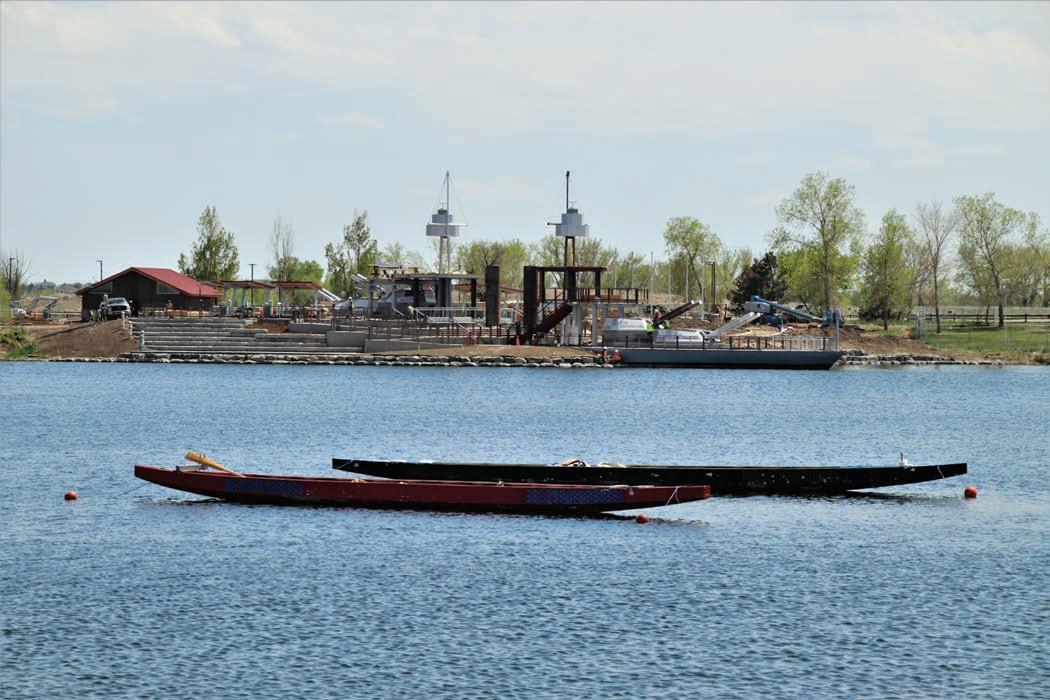
7 minute read
The U.S. dollar as world currency
There is a lot of news about the U.S. dollar (USD) and how sustainable it is as the world currency in the future. While I don’t expect a major shift away from the dollar during my lifetime, we do see currencies and their use gradually changing over time.
• Currently the USD represents 58 percent of the world’s central bank reserves. is is down from 75 percent in 2000. is reserve currency is a magnet for foreign investment in the United States, according to William Greiner, CFA®.
• Some of the reasons for the renewed interest in world curren-
Financial Strategies
cies is due to Russia, China and India talking with Brazil and South America about creating a new currency to challenge the USD. ey want to trade directly with each other in their own currencies.
Let’s take a look at the current facts, according to JP Morgan.
• China’s currency the Renminbi (RMB) was the fth most traded cur-
LINDA SHAPLEY Publisher lshapley@coloradocommunitymedia.com
MICHAEL DE YOANNA Editor-in-Chief michael@coloradocommunitymedia.com rency in the world last year.
• e U.S. share of global trade is about twelve percent, and the U.S. share of global GDP is about 25 percent. Yet the dollar’s share of foreign exchange, trade, debt, and exchange reserve is much higher, which is why the dollar is known as the world’s reserve currency.
• About 35 percent of all Treasury bonds are owned by foreign investors.
• e dollar’s role in foreign exchange markets has been mostly unchanged over the last 20 years or more. In 2022, the dollar accounted for about 89 percent of all foreign
STEVE SMITH Sports Editor ssmith@coloradocommunitymedia.com
LINDSAY NICOLETTI Operations/ Circulation Manager lnicoletti@coloradocommunitymedia.com exchange transactions. e dollar’s dominance in international nance is clear with the dollar used in about half of all trade invoicing—much higher than the twelve percent share in global trade.
• e dollar is still the dominant currency of choice for investment of foreign exchange reserves at about 60 percent.
• Some central banks are diversifying holdings away from the dollar and the euro, but only 25 percent of the shift is explained by increased allocations to the Chinese RMB. Much
SEE KUMMER, P7
Contact us: 143 S. Second Pl., Brighton, CO 80401 - 303-566-4100
Mailing Address: 750 W. Hampden Ave., Suite 225 Englewood, CO 80110
Phone: 303-566-4100
Web: TheBrightonBlade.com
To subscribe call 303-566-4100
SCOTT TAYLOR Metro North Editor staylor@coloradocommunitymedia.com
BELEN WARD Community Editor bward@coloradocommunitymedia.com
TERESA ALEXIS Marketing Consultant Classified Sales talexis@coloradocommunitymedia.com
AUDREY BROOKS Business Manager abrooks@coloradocommunitymedia.com
Columnists & Guest Commentaries
Columnist opinions are not necessarily those of the Blade. We welcome letters to the editor. Please include your full name, address and the best number to reach you by telephone.
Email letters to staylor@coloradocommunitymedia.com
Deadline Wed. for the following week’s paper.
To opt in or out of delivery please email us at circulation@ coloradocommunitymedia.com economically viable while also pushing pressure for new housing. But Colorado is slowing, too and she said that trend will continue. She noted that many of the states with the lowest birth rates are net population donors to Colorado. at means that eventually, fewer people will be moving to Colorado.
She projected continued growth of working-age residents in several counties, including Adams County.
“Now, I will tell you, Weld County represented 43% of the total growth in the under-18 population,” she said. “So, make nice with Weld County. I’ll be honest with you. Adams County is not far behind.” e region needs two things to keep attracting working-age residents — jobs and housing. She blamed the state’s current housing crunch on the boom-and-bust cycle of the state’s housing industry.
“ e Great Recession wrecked construction in building housing units,” she said. “We were building between 40,000 and 50,000 units per year and we went to 10,000. For 10 wide. years, we built fewer housing units than households that were formed. Do you think that’s a problem? We have this boom and bust cycle with housing construction, so that is something to work on.”


In his speech, Polis said he’s trying to help reduce barriers to home construction and allow alternatives to single-family homes, including duplexes and buildings with multiple dwelling units. Better supply will keep housing prices more reasonable.
“I think if we can address it sooner rather than later, we can keep Adams County from becoming Boulder and of this was driven by Russia which holds one third of all RMB reserves.

Colorado from becoming California,” Polis said.


Adams County Commissioner O’Dorisio, the rst speaker at the luncheon, said the county is investing in home repair programs to help seniors stay in their homes longer and encouraging new housing development while investing in transitional housing for the unhoused. It’s one part of an overall e ort to use the county’s assets as wisely as possible.
“We are the hub of logistics because we are where the rivers, the highways and the businesses all come together,” O’Dorisio said.
• U.S. sanctions remain on many countries, most notably the freezing of Russian assets after the Ukraine invasion.
• Commodities such as oil are priced and traded in dollars world-

• More foreign currencies are pegged to the U.S. dollar than any other currency including China’s. China is also our largest trading partner with foreign trades pegged to the dollar.
Investment Strategist Brett Lapierre, CFA ® states, “I see some weakness in the USD over the next few years as it is fundamentally overvalued. This, combined with stronger economic growth outside of the U.S., higher interest rates and trade deficit, could all put pressure on the USD. A recession could mean the dollar bounces in the short term in a flight to quality trade but over time, I expect the dollar to weaken.”


Given these facts, the U.S. dollar is alive and well and remains the stronghold currency worldwide. This could change over time as we see improved economic growth in other countries, and as we incor- porate more foreign trade.
In our opinion, it is important to make sure your investment portfolio is diversified based on your risk tolerance to include investments that can potentially benefit from these economic conditions.
Patricia Kummer has been a Certified Financial Planner professional and a fiduciary for over 35 years and is managing director for Mariner Wealth Advisors.

On the 29th of April 2023, Big Ed Stieber went to the happy hunting ground in the sky while hospitalized at MD Anderson in Houston, TX. Born March 12, 1958 to Rich and Marlene (Davis) Stieber, Eddie grew up loving the outdoors. He held passions for so many things including (in no particular order) elk hunting, his wife & soulmate Dianne, shing, bear hunting, wood working, his family, deer hunting, his nieces and nephews-including “greats”, duck hunting, camping, gardening, goose hunting, cooking-especially making salsa and pies, their cabin in Crystal Lakes, and more hunting.
After attending Fort Lupton schools and working for his dad’s Deere business, Ed’s career began with farming for Lloyd Land and continued 29 years with the Colorado Department of Transportation, where he found many, many friends, mentoring and giving advice even after retirement.
A big man with a heart just as big, he was known throughout his life for baking pies for birthday observances and special occasions. Every fall, dozens and dozens of jars were lled with his special salsa, pickles, and sauerkraut that he shared generously.
When he married his true love, Dianne Allison on December 31, 1994, she knew their kitchen was where she would always nd Ed preparing wonderful creations.



Only diagnosed recently with Chordoma, a form of cancer that attacks either end of the spinal column, Ed tried valiantly to overcome the rapid growth. Ed would have especially wished to thank family and friends who supported him following his diagnosis.
He will be mourned and missed by all his surviving friends and family: his wife Dianne, mother Marlene Stieber, siblings Zo (George) Hubbard, Chris (Liz) Stieber, & Jack Stieber as well as nephew Travis (Jessica) Stieber, nieces Sam (Rod) Dudley, Kenzie (Austin) Collier, Madison Stieber, Kyli (Marcus) Garcia and their families. He is also survived by brothers-in-law Barry (Diana) Allison (& nephew Dillon), Orie (Melanee) Allison (& nephew Justin), and adopted nephews Brady and Brycen Buum, and cousins with whom he held a very close kinship.

Gone before Ed’s passing were his dad Rich and brother Greg.
Memorial: Saturday, May 20th at 2:00 p.m. at the historic fort just west of highway 85 on County Road 14.5: 2001 Historic Parkway in Fort Lupton. All gentlemen are encouraged to wear shorts and boots-Ed’s year around attire.
BY LUKE ZARZECKI LZARZECKI@COLORADOCOMMUNITYMEDIA.COM
On most Tuesdays and ursdays and some Saturdays, a team of bikers meets to explore Colorado’s network of trails.
e group connects at a co ee shop in downtown Denver. When the weather isn’t too hot, it’s after work around 4 or 5 p.m. In the dead of summer, it’s usually in the morning.
ey sip on espresso and decide where they want to ride that day. It could be on the bike lanes of Denver, the 36 Bikeway to Boulder, the Platte River Trail to Brighton or other suburbs. Most of the time, it involves a stop along the way.
“We would go down the Platte River Trail to the C 470 trail and then Krispy Kremes along there. We call it the Krispy 50. It’s a 50-mile loop,” said Ted Schultz, one of the riders in the group.
e group started after Schultz and two colleagues in his o ce space decided to start riding together after work. Schultz rode with a few others and combined the two groups.
After the ride, they go to a brewery to catch up with one another and relax after the ride.
Colorado’s network of trails
Part of the reason the group exists is due to Colorado’s extensive bike trail infrastructure. Schultz said it’s only improved in the past two decades.
“When you add up the miles of really good trails, it’s just mind-boggling,” he said.

Schultz, who grew up in Colorado, said understanding for cyclists sharing the road and building more infrastructure has vastly grown. In the 70s and 80s, he could almost count on angry driver backlash during his rides. Now, not so much. e Denver Regional Council of Governments built a map that shows all the trails and bike lanes across the region. ey stretch all the way from Boulder to Clear Creek to Castle Rock.
Much of that may be due to more focus on improving trails and streets.
And more may be coming. e Greenhouse Gas Planning Standard, a new rule adopted by the Transportation Commission of Colorado in December 2021, requires agencies to measure greenhouse gas emissions from transit projects, with limits on how high those emissions go.






